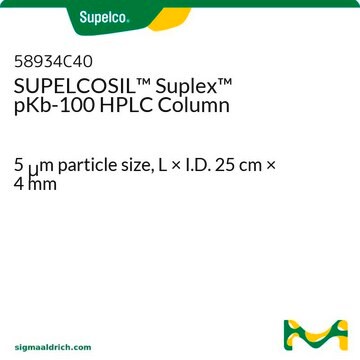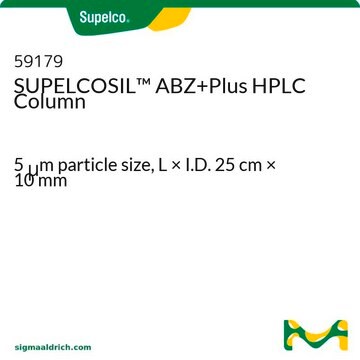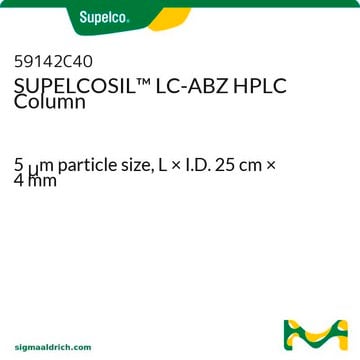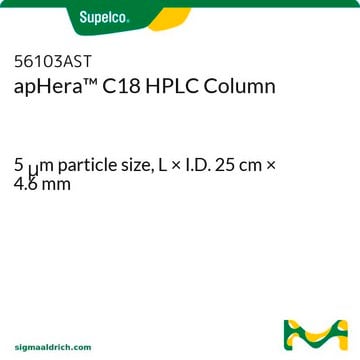58934
SUPELCOSIL™ Suplex pKb-100 (5 µm) HPLC Columns
L × I.D. 25 cm × 4.6 mm, HPLC Column
Sign Into View Organizational & Contract Pricing
All Photos(1)
About This Item
UNSPSC Code:
41115700
eCl@ss:
32110501
Recommended Products
product name
SUPELCOSIL™ Suplex pKb-100 HPLC Column, 5 μm particle size, L × I.D. 25 cm × 4.6 mm
Agency
suitable for USP L68
feature
endcapped: no
manufacturer/tradename
SUPELCOSIL™
extent of labeling
12.5% carbon loading
parameter
≤70 °C temp. range
400 bar pressure (5801 psi)
technique(s)
HPLC: suitable
L × I.D.
25 cm × 4.6 mm
surface area
170 m2/g
surface coverage
surface coverage 3.4 μmol/m2
matrix
silica gel, spherical particle platform
matrix active group
amide, alkyl phase
particle size
5 μm
pore size
120 Å
pH range
2-7.5
application(s)
food and beverages
separation technique
reversed phase
Looking for similar products? Visit Product Comparison Guide
Related Categories
General description
Suplex pKb-100 columns feature the same bonded phase functionality as SUPELCOSIL LC-ABZ columns. These specially deactivated columns differ in that Suplex pKb-100 is not endcapped, while SUPELCOSIL LC-ABZ is endcapped. The absence of the end-capping reagent results in better performance from Suplex pKb-100 for the strongest basic compounds, while LC-ABZ is preferred when the sample also contains acids and/or zwitterions.
Application
SUPELCOSIL™ Suplex pKb-100 HPLC Column was used in HPLC purification of prepurified fly ovaries. It was also used for HPLC analysis, done for the determination of retinoid.
Legal Information
SUPELCOSIL is a trademark of Sigma-Aldrich Co. LLC
guard cartridge
Product No.
Description
Pricing
related product
Choose from one of the most recent versions:
Already Own This Product?
Find documentation for the products that you have recently purchased in the Document Library.
Customers Also Viewed
A M Myhre et al.
Journal of lipid research, 37(9), 1971-1977 (1996-09-01)
Retinoylation (retinoic acylation) is a posttranslational modification of proteins occurring in a variety of cell types in vitro. This study was done to examine whether retinoylation occurs in vivo. We found that in retinol-deficient rats, radiolabeled retinol or retinoic acid
Korneel Hens et al.
European journal of biochemistry, 269(14), 3522-3530 (2002-07-24)
Angiotensin converting enzyme (ACE) was already discovered in insects in 1994, but its physiological role is still enigmatic. We have addressed this problem by purifying four new ACE substrates from the ovaries of the grey fleshfly, Neobellieria bullata. Their primary
Our team of scientists has experience in all areas of research including Life Science, Material Science, Chemical Synthesis, Chromatography, Analytical and many others.
Contact Technical Service







